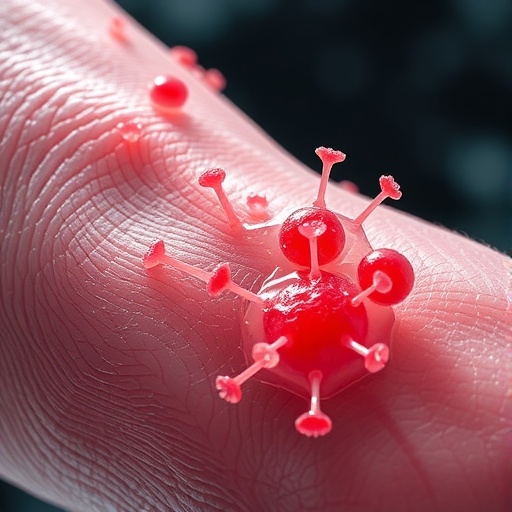
In the realm of infectious disease, one of the most confounding challenges is the stubborn persistence of Staphylococcus aureus on human skin. This common bacterium, often harmless on intact skin, can transform into a formidable adversary when the skin barrier is compromised, as seen in conditions such as eczema. Despite repeated washing, scratching, and natural skin shedding, S. aureus adheres with remarkable tenacity, frequently precipitating severe and treatment-resistant infections. Until now, the molecular mechanism behind this extraordinary adhesion remained elusive, but groundbreaking research published in Science Advances reveals a molecular handshake of unprecedented strength, powered and regulated by calcium ions.
Imagine the microscopic battlefield occurring on a patch of human skin. Among the keratinocytes, specialized skin cells that form a protective barrier, resides desmoglein-1 (DSG-1), a crucial adhesion molecule responsible for maintaining skin integrity. S. aureus employs a protein called SdrD, an adhesin molecule acting akin to a grappling hook, which latches onto DSG-1 with extraordinary vigor. This binding is not a simple lock-and-key interaction but rather a complex and powerful bond that surpasses even the strength of many chemical bonds commonly observed in nature. The strength measured rivals that of superglue, making the physical removal of the bacteria remarkably challenging.
The research collaborative, co-led by Auburn University’s Department of Physics alongside teams in Belgium and the United Kingdom, employs cutting-edge single-molecule force spectroscopy and high-fidelity computational biophysics to dissect this interaction at an atomic level. Using atomic force microscopy, scientists could measure the force necessary to disrupt the bond between SdrD and DSG-1 in exquisite detail. Parallel computational simulations modeled the molecular conformation and energy landscapes underpinning this extraordinary adhesion, confirming that the observed forces are unlike any previously reported protein-protein interactions in biological systems.
Calcium ions emerge as unexpected but indispensable players in this molecular saga. Far beyond their classical role in bone strength and cellular signaling, calcium acts here as a critical stabilizer of the SdrD-DSG-1 bond. By coordinating with specific sites on the bacterial and human proteins, calcium effectively reinforces the interface, making the bond resistant to mechanical stresses such as shear forces from scratching or washing. Laboratory manipulations demonstrated that depleting calcium significantly weakens the adhesion, while its reintroduction restores and even enhances the bond’s robustness. This finding has profound implications, especially considering that calcium distribution in the skin is often disrupted in eczema patients, potentially exacerbating bacterial colonization.
Understanding this calcium-dependent adhesion mechanism sheds light on why certain individuals, particularly those with compromised skin barriers, are exceptionally vulnerable to stubborn staph infections. The stabilizing effect provided by calcium effectively arms S. aureus with a near-indestructible hold on their human host, allowing colonies to flourish and evade clearance by immune defenses or conventional treatments. This insight propels scientific understanding from descriptive knowledge to mechanistic clarity, enabling the design of novel therapeutic strategies precisely targeted at this adhesion process.
Conventional antibiotic treatments focus primarily on killing bacteria or hindering their growth, a strategy that has unfortunately contributed to the rise of resistant strains such as Methicillin-resistant Staphylococcus aureus (MRSA). The discovery of SdrD’s ultrastable calcium-mediated grip offers a paradigm shift. By interrupting this adhesion, new therapies can disarm the bacterium’s ability to colonize skin without necessarily inducing bacterial death, thereby reducing the selective pressures that drive resistance. This approach may revolutionize the fight against persistent skin infections and represents a promising frontier in antimicrobial strategy.
Further, the multidisciplinary nature of this discovery exemplifies the power of integrating physics with biology. Auburn University’s Computational Biophysics Group utilized supercomputing resources to simulate at the atomic scale the interaction forces, binding energies, and conformational dynamics involved in this protein-protein complex under varying calcium concentrations. The convergence of empirical force measurements and theoretical models provided convincing validation, transforming speculative molecular hypotheses into concrete biological insight.
The implications extend beyond dermatology or S. aureus alone. Protein-protein interactions govern countless biological processes, and the recognition that a bacterial adhesin can forge a non-covalent bond with unprecedented strength invites reevaluation of adhesion mechanisms in other pathogens. It also raises intriguing questions about the evolution of microbial strategies for colonization and persistence on host tissues subjected to constant mechanical stress.
In clinical contexts, these findings underscore the importance of maintaining skin barrier integrity and the delicate balance of skin electrolytes, particularly calcium, in preventing infection. For patients with eczema and other skin disorders, therapeutic interventions might one day include modulation of calcium levels or direct inhibition of SdrD-DSG-1 interaction sites, providing tailored treatments that address the adhesion mechanism at its root cause.
Moreover, this research demonstrates how international collaboration can accelerate discovery, merging experimental expertise with computational prowess across continents. The team’s success in solving a longstanding mystery of staph pathogenesis exemplifies the breakthroughs achievable when diverse scientific disciplines and perspectives unite with a common goal.
As the strongest non-covalent protein bond ever observed, the SdrD-DSG-1 interaction sets a new biophysical benchmark. It reshapes our fundamental understanding of microbial adhesion, suggesting new horizons for research in microbiology, bioengineering, and medical therapeutics. This landmark study not only elucidates why Staphylococcus aureus is such a persistent clinical adversary but also lights a path toward innovative, adhesion-targeted interventions that could save tens of thousands of lives annually.
The discovery stands as a testament to how meticulously probing the molecular details of biological interactions can unlock solutions to some of the most pressing challenges in medicine. In a landscape dominated by concerns over antibiotic resistance and chronic infections, targeting bacterial adhesion represents a fresh weapon of considerable promise.
Subject of Research: Lab-produced tissue samples
Article Title: Ultrastrong Staphylococcus aureus adhesion to human skin: Calcium as a key regulator of noncovalent interactions
Web References: 10.1126/sciadv.adu7457
Image Credits: Department of Physics – Auburn University
Keywords: Staphylococcus aureus, bacterial adhesion, SdrD, desmoglein-1, calcium ions, protein-protein interaction, biophysics, atomic force microscopy, computational biophysics, MRSA, antibiotic resistance, skin infection
Tags: calcium ions in bacterial adhesiondesmoglein-1 role in skin healtheczema and bacterial infectionshuman skin microbiome interactionsinfectious disease challenges with staph bacteriakeratinocytes and skin integritymolecular handshake in bacteriaSdrD adhesin functionalityskin barrier compromise effectsStaphylococcus aureus adhesion mechanismssuperglue-like bacterial bindingtreatment-resistant staph infections




